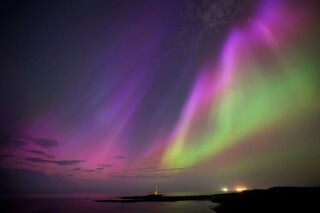Tractor Beams
Chris Lintott
The evening sky on Friday lit up with a bright auroral display. Such phenomena are usually confined to the polar regions, but this one was seen as far south as Mississippi and as far north as Melbourne. With word of the show spreading quickly online, and modern phone cameras capable of picking up even fainter lights in the sky, this must have been the most recorded display of aurorae in history.
My own most memorable encounter with the Northern Lights came twenty years ago, as the astronomer accompanying a party of tourists in Tromsø, Norway’s northernmost city. Even our local expert, an accomplished auroral photographer, was excited as we left the hotel just after sunset and immediately spotted a tell-tale shade of green in the sky. From our dark viewing site in the centre of a frozen lake, the view was spectacular, with the horizon lit up in bright shades of green, red and purple. The curtains of light in the sky shimmered and changed shape from moment to moment. At the climax of the display they swirled above us, creating an auroral crown and lighting the whole sky before silently vanishing.
The next night brought a blizzard thick enough to make walking down the street seem like a major expedition, and the tour party retired to the hotel bar. But at the insistence of our guide, who didn’t want to disrespect the lights by ignoring any chance of seeing them, we rounded up a party of half-cut aurora hunters and got them onto a minibus. A journey of several hours took us to a hill near the Finnish border, where we could see only a greenish glow through a gap in the clouds, as the snow continued to fall around us.
The aurorae have always attracted superstition. They appear in the stories of many Arctic cultures as mercurial spirits, as likely to whisk a traveller away or drive them mad as bring delight. Reports of odd behaviour – of sounds or even smells accompanying displays – are recorded alongside more prosaic descriptions right up until the space age. Even now, when their cause is well understood, our ability to predict aurorae is spotty, and watching the show is still an otherworldly experience.
The lights occur when particles – mostly electrons and protons – flung into the Solar System as part of the solar wind hit the Earth’s magnetic field, exciting atoms of oxygen and nitrogen in the atmosphere, causing them to glow. Normally, the magnetic field protects us from such solar weather (one of the reasons life is more comfortable on Earth than it would be on the surface of Mars, which lacks a magnetic field). but when more particles than usual arrive, a bright auroral oval forms around each of the planet’s poles.
It is the shape of the Earth’s magnetic field that makes this a polar phenomenon, but if the influx of particles increases, the oval brightens, broadens and shifts towards the equator. Last Friday’s show was the result of the arrival of particles generated by a series of five coronal mass ejections: explosive events in the Sun’s atmosphere caused by the twisting of its own magnetic field as it rotates, each one sending billions of tons of matter, moving at millions of miles per hour, out into the Solar System. The exact timing and strength of these dramatic events is hard to predict, but their frequency follows the eleven-year cycle of solar activity which was first revealed to those studying sunspots; as we head into the period of solar maximum predicted for the next year or so, such events should be common.
As the particles batter our planet’s magnetic field and it responds, the appearance of the lights changes from moment to moment. Individual parts of a display brighten and fade quickly, creating the impression of rapid movement and an eerie sense that changes are taking place, continually, just outside your range of vision. A display can last for several hours from any given location, but it will never look the same for more than a few seconds.
The arrival of millions of charged particles can have less benign consequences. Previous storms have caused large-scale power cuts by overloading transformers. The most famous 19th-century storm – the so-called Carrington Event, whose observers first connected solar activity to occurrences on Earth – caused the boards used by telegraph operators to spark. In the 21st century, satellite operations, with craft outside the atmosphere and so more exposed to solar weather, are especially vulnerable.
Apart from sporadic reports of trouble with tractors, which rely on signals from GPS satellites to traverse their fields precisely, this time we seem to have got lucky. Predictions of the incoming storm allowed the operators of satellites and ground-based electricity grids to prepare for the arriving particles, and those lucky enough to find themselves under clear skies at the right time were, despite the storm, able to flood social media with pictures of a display whose brightness and beauty has not been surpassed south of the Arctic for at least two decades.
